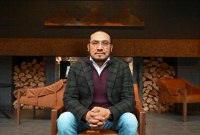Support strong Canadian climate journalism for 2025
Half a dozen First Nation youth and a couple of men circled to inspect a dusty truck with a punctured tire that had just limped into their remote camp on west Vancouver Island after a two-hour drive down a logging road.
The truck’s owner — an adult mentor with the Nuu-chah-nulth Youth Warriors program — wasn’t entirely sure how to tackle the flat on his own. But he didn’t have to because Raven and Brandon stepped up to learn and do.
With minimal guidance from mentor Randy Grey, a youth trainer with the Construction Foundation of BC, the pair worked with their buddies to figure out how to change the tire. The mystery of the missing spare was cracked by Brandon, who knew from his father-in-law to look under the truck.
It was the first of many moments of co-operation, community service and skill-building the youth would experience during a recent three-day trip with the Warrior program — a land-based learning network to develop leadership in First Nations youth while connecting them to their territories, culture and each other.

The Warriors, with youth groups in eight different nations across Nuu-chah-nulth territories, spent three days near Sarita Bay in early July constructing a traditional clam garden for the Huu-ay-aht community. When tides hampered work on the foreshore, the youth kick-started small carpentry projects or harvested traditional food and plants from the forest and sea before learning to cook them up to feed the camp.
Fresh salmon fillets, a Thai-style clam chowder with coconut milk, blanched sea asparagus tossed in garlic butter and fresh-picked huckleberries all made their way onto the tasting menu.
Typically, the Warriors meet one night a week in their own communities and spend one weekend a month on the land in remote areas in their own territories or join other groups on theirs, said Hugie Watts, the Tseshaht Warrior co-ordinator, who is transitioning to be the Warrior Society’s executive director.
Since the program’s start in 2015, the Warriors have built trails, cabins, wood sheds and smokehouses for elders locally or in neighbouring communities and have taken training courses for wilderness first aid, hunting, trapping, snorkel harvesting, power saws, and even driver’s licences.
There’s also the annual Warrior Games, which takes place in a different community each year, with Nuu-chah-nulth youth competing in events featuring traditional skills. One new event is a modified version of the feather swim, where young men traditionally swam across a river and back while still keeping a feather dry and visible above their heads, Watts said.
"It was something our people did to show their worthiness to the family of the person they're going to marry."
The Warriors program gives First Nations youth the opportunity to connect to their teachings and culture on their territory, Watts said.
“The co-ordinators talk about wishing they had this program when we were young, but now we have the opportunity to give youth what we didn't have,” he said.
“It probably would have saved me a lot of trouble being on the land when I was a kid. I was a bit of a hooligan.”

The program offers youth a safe place to build bonds, confidence and experience with the help of elders and adult mentors who share their knowledge, said Watts, who’s been part of the program for two years.
“Once we establish our relationships with each other, it’s like family,” Watts said, adding youth need people who consistently show up and support them.
"Some youth aren't in the greatest situations," he said. "We need to be there for them, believe in them, and be like, 'Hey! You can do these amazing things.'"
The youth and co-ordinators in each community determine what they want to learn and do, he said.
In addition to traditional learning, his Warrior group is focusing on building skills that will lead to meaningful work, Watts said.
If a youth identifies a particular training they want or sets a personal objective, the Warrior program finds a way to help them achieve it, he added.
"We'll get them the certifications they need and build them up in that role."
The program relies heavily on traditional leadership and teachings but incorporates new methods and knowledge.
"We're going about this our own way, so the youth get the best of both worlds."
The program is designed for young people to support each other. It allows them to try something that interests them while leaving room for trial, error and improvement without any toxic joking or bullying, Watts said.

At day’s end, the Warriors hold a circle where everyone can share what they enjoyed or learned, and if they choose, can take the opportunity to acknowledge the positive contribution of individual youth.
Co-ordinator and camp cook Randi-Leigh MacNutt took the moment to recognize a young Warrior named Chance for crawling out of bed at 5:30 a.m. to make sure she wasn’t working alone in the mess tent preparing breakfast.
Grey commended a group of warriors who collaborated to make a bench with the tools he’d brought for them to practise with.
“I always encourage you to try everything and fail quickly and often,” Grey said, noting it is the fastest route to learning.
“You worked together better than most adults would have,” he said.
Mentor Ty Styner thanked the Warriors who’d worked to successfully change his truck tire.
Despite being in his mid-20s, it’s not something he knew how to do, and it helped him out of a potentially stressful situation, he said.
“A lot of people would have made fun and puffed up their chests,” Styner said.
“You always lift each other — and me — up,” he added.
“Thank you for helping when I needed it, as you always do.”

Rochelle Baker / Local Journalism Initiative / Canada’s National Observer







Comments